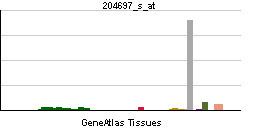Species Human Entrez 1113 | Human Mouse Ensembl n/a | |
 | ||
Aliases CHGA, CGA, chromogranin A External IDs OMIM: 118910 MGI: 88394 HomoloGene: 976 GeneCards: CHGA | ||
Chromogranin A or parathyroid secretory protein 1 (gene name CHGA) is a member of the granin family of neuroendocrine secretory proteins, i.e., it is located in secretory vesicles of neurons and endocrine cells such as islet beta cell secretory granules in pancreas. In humans, chromogranin A protein is encoded by the CHGA gene.
Contents
Tissue distribution
Examples of cells producing chromogranin A (ChgA) are chromaffin cells of the adrenal medulla, paraganglia, enterochromaffin-like cells and beta cells of the pancreas. It is present in islet beta cell secretory granules.
Function
Chromogranin A is the precursor to several functional peptides including vasostatin-1, vasostatin-2, pancreastatin, catestatin and parastatin. These peptides negatively modulate the neuroendocrine function of the releasing cell (autocrine) or nearby cells (paracrine).
Chromogranin A induces and promotes the generation of secretory granules such as those containing insulin in pancreatic islet beta cells.
Clinical significance
Chromogranin A is elevated in pheochromocytomas. It has been identified as autoantigen in type 1 diabetes. A peptide fragment of ChgA located in the Vasostatin-1, namely ChgA29-42 has been identified as the antigenic epitope recognized by diabetogenic BDC2.5 T cells from type 1 diabetes prone NOD mice.
It is used as an indicator for pancreas and prostate cancer and in carcinoid syndrome. It might play a role in early neoplasic progression. Chromogranin A is cleaved by an endogenous prohormone convertase to produce several peptide fragments. See chromogranin A GeneRIFs for references. In immunohistochemistry it can be used to identify a range of neuroendocrine tumours and is highly specific for both benign and malignant cells of this type.
There are considerable differences in the amino acid composition between different species' chromogranin A . Commercial assays for measuring human CGA can usually not be used for measuring CGA in samples from other animals. Some specific parts of the molecule have a higher degree of amino acid homology and methods where the antibodies are directed against specific epitopes can be used to measure samples from different animals. Region-specific assays measuring defined parts of CGA, CGB and SG2 can be used for measurements in samples from cats and dogs.
